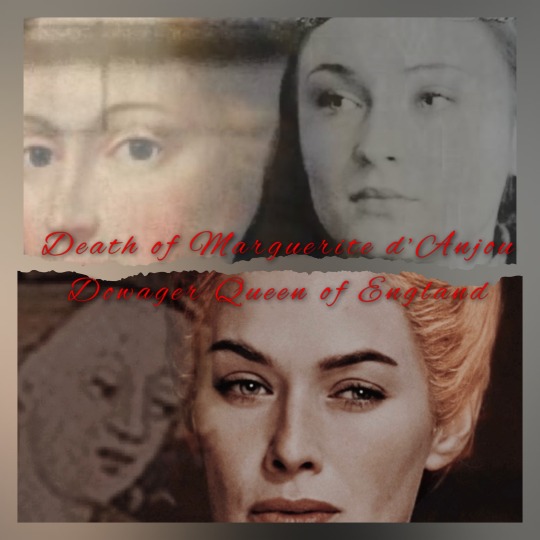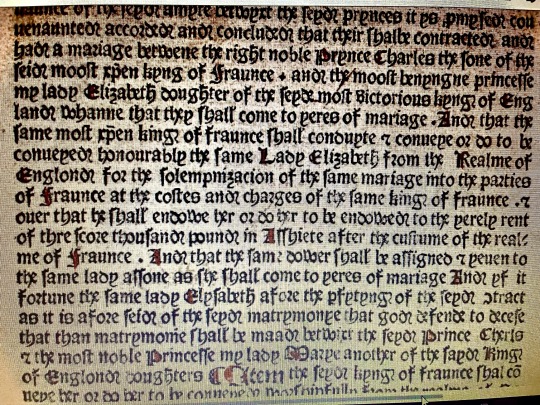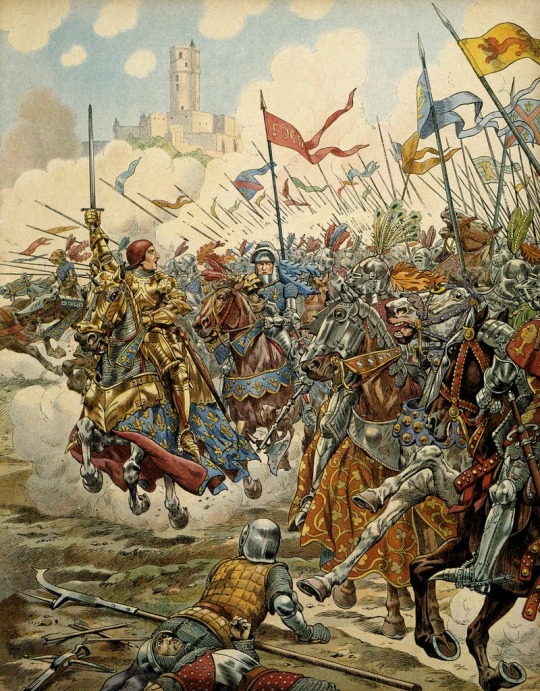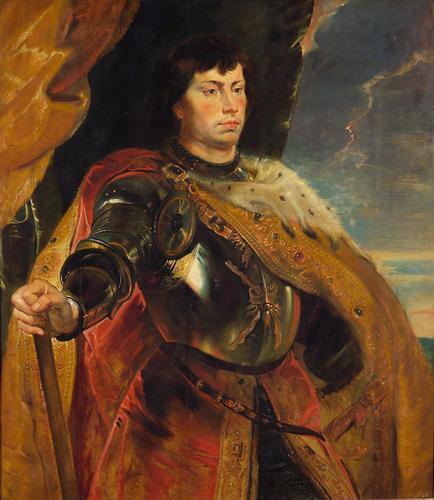#louis xi
Text




#season 1#louis xi#abbot of beyne#the pig piano#no context horrible histories#mathew baynton#mat baynton#ben willbond#horrible histories#the six idiots
10 notes
·
View notes
Text
About Marie d'Anjou
After losing four children between 1436 and 1439, Marie began to dress all in black. She was devoted to her household, her religious duties and her children. She was admired for her piety, leading a devotional life. Marie appears to have had no chancellor in her household as her seal was kept by one of her ladies-in-waiting, perhaps in an effort to keep her household out of internecine politics at court. She normally resided at Tours or Amboise and did not usually travel with the court.
Marie kept a large menagerie of pets including starlings, parrots, a wild goat, stags and does, in addition to her greyhounds. She also received a porpoise as a gift. Perhaps this is where her son Louis learned to love such exotic pets. Marie was an expert needlewoman. Her account books for the years 1454 and 1455 attest she embroidered every day with gold thread from Cyprus, Genoa and Venice with a cushion stuffed with bulrush and patterns on canvas from Cambrai.
Marie had a musical chapel with fifteen members. Two of these chaplains were composers of polyphonic music. Marie was the first queen to officially have an astrologer in her household according to the account books of 1450. His name was Arnoul de La Palu and he was regularly paid by the queen until Arnoul left to go into the king's service. He was quickly replaced by Jehan de Lormont.
Marie remained very close to her family and frequently kept in touch with her brother René, Duke of Lorraine. René visited her and she borrowed his boats to sail up the Vienne and Loire Rivers for visits. A list of New Year's gifts for 1455 for the most part included gifts to her brothers and sister-in-law Joan of Laval. Marie and the king made a pilgrimage together to Le Puy in 1424. In 1447, Marie made a pilgrimage on her own to Mont St. Michel.
Susan Abernethy - Marie of Anjou, Queen of France
#xv#susan abernethy#marie of anjou queen of france#marie d'anjou#queens of france#louis xi#le roi rené#jeanne de laval
25 notes
·
View notes
Text

“24 August 1482
From the fairytale turrets of Saumur Castle, atop which golden fleur-de-lys glistened in the summer light, to the bulbous towers of Angers, where the château loomed on a cliff edge above the River Loire, the funeral cortege of Margaret of Anjou carried the queen on her last journey.
For six years she had been exiled back to the lands in which she grew up, a half-welcome guest of her father and King Louis, with little more than hunting dogs, books and a casket of relics to remind her of past glories. She was going now to rejoin her ancestors. Her last request to King Louis was that he would allow her to be buried with her parents: in their sepulchre at Angers Cathedral.
Since her capture at Tewksbury in 1471 Margaret's life had become one of solitary retirement. She had not stayed long in the Tower of London, although she must have been there when Henry was killed.
For a time she was kept at Windsor Castle, and by January 1472 she had moved to Wallingford in Oxfordshire, where her keeper was her old friend, Alice Chaucer, dowager duchess of Suffolk.
The women had once been close, Alice perhaps even having something of a maternal place in Margaret's heart. Since Suffolk's murder their lives had taken very different courses, and their enforced time together during Margaret's imprisonment cannot have been entirely happy.
Where Margaret had resisted the Yorkist regime with all her strength, Alice had come to terms with it even before Henry VI was first deposed. In 1458 Alice had overseen the marriage of her only child, John, to York's daughter Elizabeth. At the time this must have seemed a dangerous move, but her gamble had paid off. Her son still lived, a prominent member of the court of King Edward IV, and a king's brother-in-law.
Margaret, by contrast, had lost her family to the wars. Under house arrest, she was reliant on Edward to provide her with enough money to cover the expenses of herself and her servants.
One of those servants was Lady Katherine Vaux. Katherine had lost her husband, Margaret's old servant Sir William, at Tewksbury and the pair were bound so tightly together, whether through shared grief or the loyalty of many years' service, that Katherine stayed with Margaret until the end.
The pair of them probably appear in an image in the Guild Book of the London Skinners' Fraternity in 1475. Margaret wears an ermine-lined dark gown, her head covered like a nun, kneeling forward to read a religious text from her prayer book while a discarded crown and sceptre lie beside her. Behind Margaret is a more fashionably dressed woman, evidently in attendance on the queen, with her prayer book in her hands, her eyes more on her mistress than her prayers.
Both Katherine and Margaret were members of this fraternity in honour of the Assumption of the Virgin Mary who Margaret, like Henry, always particularly revered. As this image in the Skinners' record suggests, Margaret's imprisonment under Edward IV was not especially stringent.
Other members of the Skinners' Guild Fraternity included Queen Elizabeth Woodville and her ladies, so the fraternity would not have risked their ire by welcoming Margaret without their consent.
Margaret was provided with clothing, mostly black, at royal expense and had enough freedom not only to join this guild but also to enjoy the services of the dean of Edward's chapel in 1474. Having moved from Wallingford to London for most of the intervening years, in 1475 an international treaty between Edward and Louis XI was finalized that ransomed Margaret to Louis for £50,000.
In return for being able to return to her father's territories with a small pension from Louis, Margaret was forced to renounce all of her claims not only in England but also in France. The woman who had clung so tenaciously to her family's right to the English crown was now willing to give up virtually everything she owned to go home. After all, there was no one to inherit her titles or lands after her death. Thus, in November 1475, she was transferred into the keeping of Sir Thomas Montgomery to be escorted to France.
For several years Margaret lived in her father's castle at Reculée, near Angers, but when René died in 1480 she had to rely on one of his servants to provide her literary interests. Some years earlier she had commissioned the Burgundian memoirist Georges Chastellain to write Le Temple de Bocace, a consolation piece dwelling on the changing fortunes of the world and the unjust criticism that had been levelled at her.
Presumably she also occasionally rode or hunted through the verdant rolling fields and woodland surrounding her, enjoying at least one pastime from her old life. Margaret may have ridden from her modest home at Dampierre to the more imposing Château Montsoreau on the banks of the River Loire, over time she developed enough of a relationship with he castle's owner, Madame de Montsoreau, to gift her all of her hunting dogs shortly before her death - a high-status offering for a lady who had perhaps been a friend in the queen's last years.
In the summer heat of 1482 Margaret fell ill and, with the faithful Katherine Vaux at her side, she made her last will and testament on 2 August. Louis XI, who had once mocked her proud writing style, would have found little to displease him in the humble petitions that filled this short document.
'Sound of mind, reason and thought, however weak and feeble of body', Margaret asked to be buried in the cathedral church of St Maurice in Angers beside her parents, 'in whatever manner it pleases the king to ordain, or in another place if he prefers'.
She wrote that she did not have enough money to cover the cost of the funeral and suggested that Louis sold her remaining possessions to pay for her burial - as indeed he did.
And perhaps thinking of Lady Katherine, she 'recommend(ed] very humbly and affectionately' her 'poor servants... to the good grace and charity of the said King'. She had evidently lived on the charity of others for some time, and implored Louis, as her sole heir, to cover any remaining debts she had incurred.
Louis did as Margaret asked and had her honourably buried with her parents, but he insisted on reclaiming the hunting dogs that she had gifted to Madame de Montsoreau. 'You know (Margaret] has made me her heir, the king reminded Montsoreau in a letter written days before the queen actually died, 'and that this is all I shall get; also it is what I love best. I pray you not to keep any back, [or] you would cause me a terribly great displeasure’.
Even in death, Henry and Margaret were the pawns of others.”
JOHNSON, Lauren. “Life and Death of Henry VI”.
Fan cast: Sophie Turner as young Marguerite and Lena Headey as Queen Marguerite.
#margaret of anjou#Marguerite d’Anjou#reine marguerite d'angleterre#queen Marguerite#queen margaret of Anjou#queen margaret#house of lancaster#Plantagenet dynasty#wars of the roses#cousin’s wars#Katherine vaux#Alice chaucer#Edward iv#Elizabeth of York#duchess of Suffolk#Henry VI#king Henry VI#Louis XI of France#Louis XI
19 notes
·
View notes
Text

Excerpt of the Anglo-French treaty upon which was arranged the betrothal between Dauphin Charles of France and the lady Elizabeth of England.
“(...) shalbe contracted and had a mariage betwene the right noble Prynce Charles the sone of the seid most xp̄en kyng of Fraunce. and the moost benyngne princesse my lady Elizabeth doughter of the seyde most victorious kyng of England, etc. [Dated: Amiens, 29 Aug. 1475.”
#elizabeth of york#charles viiii#house of york#house of valois#plantagenet dynasty#edward iv#louis xi#primary sources#medieval England#public domain#bl.uk
8 notes
·
View notes
Text



King Louis XI of France leading his army into the Battle of Montlhéry
#louis xi#louis xi of france#king louis xi#france#french#cavalry charge#cavalry#medieval#knights#armour#chevaliers#europe#european#history#art#job#army#battle montlhery#kingdom of france#battle of montlhéry#jacques onfroy de bréville#plume#plumes#knight
30 notes
·
View notes
Text

5 notes
·
View notes
Text
Highlights from the divorce trial of Louis XII
In 1498, King of France Louis XII launched a trial against his wife so he could divorce her, and secure a much more valuable marriage with Anne, duchess of Brittany. Divorce trials for Kings were settled by the Papacy, and, thankfully for Louis, he had just allied himself with the current Pope, Alexander VI Borgia...
Some highlights:
- 27 witnesses testified for the King, and only 3 - selected by the King himself - for his wife Jeanne.
- The King's prosecutor tried to prove Louis and Jeanne's union was incestuous, because Jeanne's father was Louis' godfather, making Louis and Jeanne spiritual siblings.
- The King's men tried to convince the judges that Jeanne's father, Louis XI, forces Louis to marry his daughter, rendering the marriage illegal. To prove this point, a witness testified that the tyrannical Louis XI terrified "not only the men of his kingdom, but also the trees" (??)
- To further emphasize that this marriage was forced upon Louis, the prosecutor insisted on Jeanne's ugliness. He explained that when Louis' mother met Jeanne for the first time, she was so taken aback that she fainted on the spot.
- Unfortunately for Louis, canonical law didn't recognize ugliness as a valid cause for divorce (only as a valid reason to break off a betrothal)
- Witnesses claimed Louis XI had hated Louis since he was a baby, because when baby Louis was being baptized, he pissed on the King's hand, which the superstitious Louis XI interpreted as a sign of a inherent rebellious nature
Louis XII DID manage to divorce his wife. Something French Kings had often tried to do, rarely with success. Not a great win for fair and ethical trials though...
2 notes
·
View notes
Text

King Louis XI of France.
#royaume de france#maison de valois#les rois maudits#louis xi#roi de france#vive le roi#full length portrait#cigarette cards#full-length portrait
7 notes
·
View notes
Text
The Formation of the Valois Burgundian Empire - Charles the Bold
The last in a four part series on the formation of the Valois Burgundian Empire
Portrait of Charles the Bold, Duke of Burgundy by Peter Paul Rubens
Charles the Bold, the fourth and last Valois Duke of Burgundy, was born to Isabel of Portugal on November 10, 1433, at Dijon, Burgundy. For political reasons, he was married to Catherine of Valois, daughter of King Charles VII of France. Once widowed, his father arranged a marriage to Isabella of Bourbon, who also died after…

View On WordPress
#Alsace#Battle of Nancy#Charles the Bold#Duke of Burgundy#Emperor Frederick III#Guelders#King of France#Lorraine#Louis XI#Low Countries#Mary of Burgundy#Maximilian of Habsburg#Valois dukes of Burgundy#Valois dynasty
5 notes
·
View notes
Text
CROWN IN EXILE: A NOVEL OF RICHARD AND EDWARD IN BURGUNDY
A part of Richard III’s life often overlooked in fiction is the brief time he spent in exile with his brother, Edward IV, from October 1470 to March 1471. Usually, this event is a mere footnote in most novels, no doubt because it might be seen as ‘slowing down the action’ and also because the documentary sources are quite jumbled and difficult to tease out. For instance, at one time it was…

View On WordPress
#"Beauforts"#Anthony Wydville#Barnet#Belgium#Bruges#Burgundy#Charles the Bold#Crown in Exile#Edward IV#Edward of Lancaster#exile#George Duke of Clarence#Gruuthuse#Henry IV#Jehan de Wavrin#John Ashdown-Hill#King&039;s Lynn#Lord Hendrik van Borselen#Louis de Groothouse#Louis XI#Margaret of Burgundy#museums#Netherlands#novels#Princes of Wales#publishing#Ravenspur#Readeption#Richard III#Richard of Warwick
0 notes
Text
History: The Bastille & Bastille Day
History: The Bastille & Bastille Day
On July 15, France celebrated its national holiday. This day is commonly called Bastille Day outside France as it is the anniversary of the storming of the Bastille, a 18th century prison in 1789. In honor of that, today I’m going to look at the Bastille, its history and why the French celebrate storming it. And if I’m listening to the band Bastille as I write, who’s going to tell?
Let’s set the…

View On WordPress
#Bastille#french history#French Revolution#international observances#Louis XI#Louis XIV#Man in the Iron Mask#Marquis de Sade#voltaire
0 notes
Link
Louis XI rentre en France humilié, mais nullement découragé. Faute de pouvoir dés maintenant prendre sa revanche sur la Bourgogne, il va s’employer à soumettre les trop puissants seigneurs du royaume. En 1472, la mort du duc de Berry lui permet de ramener la Guyenne à la couronne. Puis il se débarrasse définitivement du duc d’Alençon, en le faisant mettre au cachot. Quant au duc de Bretagne, vaincu et affaibli, il signe une trêve protestant de sa soumission au roi. Reste encore la dangereuse famille d’Armagnac. Jean V, son chef, s’est enfermé dans la forteresse de Lectoure. Louis XI envoie une expédition contre lui. Jean V accepte de faire la paix mais, pendant les négociations il est assassiné, et son frère Charles, accusé à tort ou à raison de toutes sortes de crimes, est condamné à la détention perpétuelle. Ainsi tous les grands féodaux sont soumis, à l’exception d’un seul, le plus redoutable : le duc de Bourgogne.
0 notes
Text
Red like the Oriflamme
At various times in their histories, the kings of the Iberian Peninsula, of Scotland, of Poland, and especially of England also had coronation mantles in the color red, a symbol of their power and prestigious inheritance of antique purple. Only the kings of France, who were always asserting their difference from other monarchs, never wore such a mantle. We do not know in exactly what attire the first Capetian kings were coronated, but beginning with Philip Augustus crowned in 1179 while his father, Louis VII, was still alive, and until Charles X, lavishly crowned in 1825 according to the ritual of the Ancien Régime, that mantle was always d'azur semé de lis d'or. The azure, moreover, which was a relatively light blue in the seventh and eigth centuries, tended to become darker over the course of time and sometimes to take on purplish or crimson shades.
If French kings never wore red copes or mantles like the emperor and most other sovereigns, they did, on the other hand, make use of a red ensign for more than three centuries: the oriflamme. The legend of its origin makes it Charlemagne's standard, "of a vermilion color as sparkling as gold", The Song of Roland tells us. According to a more modest version, it was a matter of a simple feudal banner, cut from plain red cloth and belonging to the abbey of Saint-Denis. As the abbey could not wage war, it was represented in battle by an "avowed", the Count of Vexin, who, in rallying his troops, came to the abbey itself where the banner was kept to collect it. Philip I inherited the Vexin countship in 1077, and henceforth it was the kings of France who had the honor of bearing the oriflamme of Saint-Denis into battle. It seems that Louis VI, son of Philip I, was the first to actually do so, in 1124, and Louis XI did it for the last time during the Battle of Montlhéry in July 1465. A simple monochrome gonfalon of the feudal period, the oriflamme seems to have been given long flying tails during the Hundred Years War and sometimes to have been decorated with flowers, rings, flames, or small crosses. All these materials, objects, and practices underscore how the color red maintained direct ties with power in the medieval West, with sovereign power but also feudal power, and representative power.

Michel Pastoureau - Red, the History of a Color
#xi#xii#xiii#xiv#xv#michel pastoureau#red: the history of a color#the oriflamme#philippe i#louis vi#louis vii#philippe ii#philippe auguste#battle of montlhéry#louis xi#hundred years war#abbey of saint-denis
6 notes
·
View notes
Photo



This beautiful blue and gold costume first appeared in the French TV movie Louis XI, le pouvoir fracassé (Louis XI, Shattered Power) in 2011 on Bruno Debrandt as Louis d’Orléans (future Louis XII). Then it was seen in 2013 in The White Queen, on Joren Seldeslachts as Charles, Duke of Burgundy. It went on to be used in The Hollow Crown‘s second season in the Henry VI, Part 2. It was worn by Andrew Scott as the French king Louis XI.
Costume Credit: Lucia
Follow: Website | Twitter | Facebook | Pinterest | Instagram
#Louis XI le pouvoir fracassé (Louis XI Shattered Power)#bruno debrandt#the white queen#joren seldeslachts#the hollow crown#andrew scott#costume drama#period drama
344 notes
·
View notes
Text
Media: Holivia is engaged and exchanged rings!
Harry: naked hands to perform
Media: Harry wore the peace ring for Larry
Harry: wears the peace ring again, wears purple and yellow to match Louis



#peace ring#louis tomlinson#harry styles#hslot nyc residency x#hslot nyx residency xi#9.8.22#9.7.22#2022#larry stylinson#coded clothing#matchymatchy#husbands on tour
68 notes
·
View notes
Text

Portrait of Louis XI of France
#louis xi#louis xi of france#king louis xi#art#painting#history#france#portrait#jacob de littemont#king#roi#kingdom of france#europe#european#king louis xi of france#medieval#middle ages#le roi
10 notes
·
View notes